Havana, Cuba
Travel to Havana, Cuba, and you'll find yourself wandering through a city that feels like it's perpetually dancing to an irresistible rhythm. It's a place that, oddly enough, seems to hum with its own unique melody, where the pastel-colored facades of the aging colonial buildings echo with stories of a vibrant past. Picture the narrow cobblestone streets, buzzing with life but also moments of serene quiet—a contradiction or perhaps just a balance that defines Havana. The air is thick with the scent of aged tobacco mixing with the saltiness of the nearby sea, mingling with the bittersweet aroma of freshly brewed Cuban coffee. Ah, and the flavors! The taste of a hot, buttery empanada paired with a glass of cold mojito that somehow feels essential under the blazing sun; come to think of it, it’s as if Havana’s very essence is captured in these simple pleasures. As you stroll along the Malecón, the city's legendary seawall, the sounds of suave, lively salsa fills the evening air, pulling you into a spontaneous dance—there's something a bit magical and maybe even nostalgic in that. Perhaps it’s the juxtaposition of vibrant murals against the faded elegance of its squares that makes it so distinct and memories linger here like ghosts. I guess, thinking about it, there’s a certain chaos—a beautiful mess—in Havana, Cuba, yet you can't help but feel it also effortlessly comes together as a complete, enchanting whole. Travel to Havana, and it becomes a journey through a kaleidoscope of sights, sounds, and flavors that evoke every emotion. Yes, it certainly leaves you with plenty to ponder over. Perhaps it feels, in some weirdly comforting way, that the city’s calling you for a deeper exploration of its heartfelt stories. Or maybe it's just me romanticizing it. Either way, that's just part of the enigmatic allure of Havana.
Havana, Cuba Travel Season
Travel to Havana, Cuba. . . it's really like no other experience. When we talk about the best time to visit Havana, it’s tempting to just point out the obvious: December to May. That's when the weather is at its most agreeable, with sunny days and cool breezes making life a little more beautiful. But, and this is a bit of an aside, it’s also when everyone else wants to visit. You know, peak season, where tourists—people like us—flood the iconic streets, sipping mojitos, dancing like the locals do (or at least trying to). It’s the season of activity, color, and let’s face it, crowds.
Now, if you’re like me and sometimes enjoy having a bit more space to breathe and wander freely, you might look at the shoulder seasons. We’re talking about late November or early June, just on the fringes of that peak window. You occasionally have to navigate some rain, it's true, but there's a certain charm in exploring Havana when it's less dominated by touristy noise. Imagine wandering the Paseo del Prado, perhaps slightly damp but definitely less congested. And I reckon those unexpected rain showers have their own allure—they bring a kind of freshness to the air and an unpredictability that adds to the adventure.
Besides pondering weather and crowds, there's the whole matter of what’s actually happening in Havana during different times. Festivities like the Havana Jazz Festival make January an exciting time to visit. Come to think of it, festivals add a vibrant layer to travel, blending in with the inherent rhythm of Havana. But then again, times like July and August can be essentially very Cuban, with celebrations for the Revolution Day and Carnival, though they might also coax you to remember the heat that accompanies that festivity.
Funnily enough, when I think about traveling to Havana, Cuba off-peak, I kind of relish those quieter moments. I mean, there's something to be said for engaging with a place when it's a little less 'on display' for travelers. The off-peak months of September and October, while dodging hurricane weather, are when you might find Havana at its most genuine, albeit a bit raw around the edges. So, while some days might feel like they hover under the threat of clouds, they also give travelers a fresh, more grounded brush with everyday life in Havana.
It’s odd that I think about it this way, but really, traveling somewhere off-season feels somewhat rebellious—as though you’re opting out of the expected. But these periods also offer discounts, lesser queues, and a rare intimacy with the local culture. Looking back, maybe it’s not so much about finding the 'right' time to travel to Havana, Cuba, but more about what you want from that trip. Personally, I like it when travel surprises me, leaving me with more questions than answers.
So, I’m left with the idea that travel to Havana is almost like an ongoing conversation, or like a dance, where timing is everything, but maybe not in the way we always think. The truth is, whether you're enveloped by the carnival's chaos or strolling through a quieter street in Cascorro, Havana has a funny way of getting into your thoughts long after you’ve left. It’s not just the timing of your visit, but how the city weaves itself into your travel narrative, however you choose to write it.
The Weather and Seasons in Havana, Cuba
Travel to Havana, and you'll find yourself in a city with weather that's as colorful as its vibrant streets. When you think about the climate of Havana, Cuba, there’s this undeniable rhythm to it. The city dances between a tropical savanna climate with a peculiar segue into a bit of a tropical rainforest feel. Temperatures, they flirt between the highs and lows quite playfully, you know, like they’re keeping you on your toes. Typically, you’ll find the mercury hovering somewhere around 80°F (27°C) to 90°F (32°C) in the summer months. Winter, if you can call it that, nudges you with a gentle 70°F (21°C). Sometimes it dips slightly lower—what some might daringly consider nippy. Funny how temperatures can be interpreted so differently depending on where you’re from. But oh! The humidity. It likes to linger. It’s like a too-long embrace after a friendly chat—they just don't let go easily.
Now, about that rain... Well, what's travel to Havana without getting a little showered on? The wet season plays out from May to October when the city gets its fair share of precipitation. But it’s this kind of rain that you almost forgive—like a friend who’s late but brings good news. It waters the lush greens you’ll see everywhere, making Havana feel alive in a way that other capitals just don't quite capture. Yet there’s something perversely wonderful about it—like it enriches the experience. For some reason, when I think about the rainfall—no, scrap that—I feel it adds a layer of authenticity to the place. Of course, then comes the dry season from November to April and suddenly, Havana feels somewhat subdued but still charming, less drizzly but more... reflective, perhaps?
When is it best to travel to Havana, Cuba? That's the million-dollar question, isn't it? Funny, once you think of it, the ideal travel time might just be all about timing and preferences. Most folks tend to opt for the dry season, around November to March. It makes sense, traveling to Havana during this time means you'll dodge the brunt of the hurricane season, which peaks around August and September. But here's where I wonder; perspective matters. The dry months lure in travelers with their sunny skies and gentle breezes, making it the prime time for those who prefer fewer weather surprises. However, there’s an argument to be made for visiting during the less predictable months if you like a sense of adventure—there’s a kind of no-strings spontaneity to it.
The cultural fabric of Havana interweaves tightly with its weather, creating this tapestry that both tourists and locals ebb and flow alongside. The Havana Carnival in July? A spectacle like no other, where the heat and energy are as palpable as the music in the air. Sometimes, I ponder... does the city's vibrancy emanate more from its people and events or is it fed by the very climate that some consider unpredictable? It's this mingling of heat, life, and rain that seems to concoct the essence of Havana itself. As I sit here, typing out this reflection, it occurs to me—the city is so bound by its climate that it’s a character in its own right. So, pack your bags with both sunscreen and an umbrella. Think of it as an invitation to dance with Havana's weather. And trust me, it’s a dance worth taking.
Accepted Payment Methods and Other Payment Information in Havana, Cuba
When you think about traveling to Havana, Cuba, there's this beautiful mix of old-world charm and modern-day realities you have to juggle with. Payment options, for one, are like a little puzzle you have to figure out, which is kind of fun, but also a bit of a headscratcher. At least for someone like me who sometimes loses their train of thought mid-writing. Now—before I dive too deep—remember Cuba's currency is something totally unique. They use the Cuban Peso (CUP), which is quite distinct from the everyday currencies most travelers are used to. Sometimes, I wonder why they don’t make it simpler...but then again, maybe that's part of Havana's charm, right? Anyway, hold onto that thought.
Also, and this is crucial when you travel to Havana, credit card usage is, let's say, a bit unpredictable. If you’ve got a Visa or a Mastercard, you’re mostly in luck. These cards are generally accepted in most places catering to tourists, but, ah, here’s the rub: American Express and Discover. They’re like those wild cards in a deck—sometimes useful, but more often just nice to look at (if they even get looked at). Truth be told, these cards don’t get a lot of love in Havana. It’s not their fault; it’s just...complicated. I sometimes wonder if they even realize it.
And speaking of complications—let's talk cash. The weight of cash in Havana is literal and figurative. It’s still king in so many transactions. Like, you go to a restaurant, or you want to snag a drink at a local bar, having some Cuban Pesos on you is pretty much non-negotiable. The odd thing is, using cash feels both freeing and cumbersome. Remembering to always keep some on hand can become its own kind of adventure, kind of unpredictable—a bit like trying to get all these thoughts down at once.
Now comes the tricky dance of tipping etiquette. Tipping won't make or break your Havana trip, but you know, it’s just this small thing that can make someone’s day. In restaurants, a tip of around 10% is the norm, though sometimes I think, hey, if service was particularly good, why not add a bit more? It never hurts to be generous. Wait, maybe sometimes it does. But in a good way. And if you end up at a hotel or using a guide, tipping follows the same loose ‘10%’ kind of guideline. The precise amount can depend on your own experiences, thoughts on service, or just how much change you happen to have on hand. Maybe that's why it's called loose—pun intended or not, you decide.
When it comes to travel to Havana, Cuba, one last thing. There's this amusing aspect of payment: standing in lines. Banks can sometimes be a slow slog—a reflection point, if you will, of your patience and endurance. Often, you'd find yourself contemplating life's greater meaning or, more practically, just how you'd rather be wandering the streets of Old Havana. And come to think of it, isn’t that what travel's all about? Embracing the unexpected, the quirks of a country like Cuba, with all its contrasting elements? Maybe, just maybe, that's what keeps drawing people back to Havana.
Why You Should Travel to Havana, Cuba
Ah, Havana—a place wrapped in mystery, steeped in rich cultural tradition, and pulsating with vibrant energy. When you think about travel to Havana, you're hit with a blend of colors, sounds, tastes. It's a city that has captivated the hearts and imaginations of travelers for decades, and for good reason.
Historic Architecture
Travel to Havana, Cuba, and you'll quickly find that its architecture is like a time capsule, preserving different epochs in stunning facades. One minute you're standing in front of an art deco cinema, the next you're leaning against a baroque pillar. The city's colonial mansions and pastel-colored buildings seem frozen in time, offering a slow-motion glimpse into the city's dramatic past. It's odd that I never tire of strolling its cobblestone streets, marveling at the intertwining of neglect and restoration.
Street Music
Now where else can you experience music spilling out from nearly every corner? Bands make you want to sit, stay a little longer than you planned, caught up in melodies that have woven their way into the soul of the city. In Havana, you’ll find spontaneous son, jazz, and rumba performances on the street, giving you that authentic feel… almost like the city itself is performing a never-ending concert. It’s quite magical, come to think of it. It’s like the city has its own soundtrack—a bit of chaos, a bit of charm.
The Vibes of Old Havana
Ever just wander through a place and feel like you're in a different era? That's Old Havana for you. It's a UNESCO World Heritage site, by the way, which makes the experience feel—how do I put this—more special, like every corner you turn has a hidden story just for you. There’s an intimate charm about it; you see, it's like an open-air museum, yet so alive and filled with locals living their everyday lives. Sometimes I question if I've stepped onto a movie set, and I'm just one of the extras living out my own adventure.
The Cars, Oh The Cars
Those vintage cars roaring down the Malecón? Pure eye candy for any car enthusiast or anyone who appreciates nostalgia. Imagine cruising in a cherry red convertible from the 1950s. It’s an exhilarating experience that turns your travel to Havana into a joyride through history. There's this undeniable charm seeing these classic vehicles still, somehow, running smoothly on streets lined with palm trees. Yet another layer of Havana where the past and the present blend seamlessly. It's curious how these cars continue to define the cityscape in such a bold way.
Cuban Cuisine
And oh, the food! Let’s talk about the culinary scene for a bit. Travel to Havana and you will find mouthwatering dishes that mix Spanish, African, and Caribbean influences. It's hard not to overindulge in ropa vieja or picadillo, and maybe that's okay. My taste buds dance to the rhythm of Cuba every time I savor the local cuisine. But with every bite, I can't help but wonder if my love for Cuban food is more about these flavors simply whisking me away to some far-off memory.
Hop on the Cultural Train
Havana, Cuba is a cultural patchwork, where Afro-Cuban music, dance, and religious traditions pulse through its very heartbeat. Witnessing a Santería ceremony or watching a local rumba performance connects you to Havana in a way that's not just skin deep. But then again, it’s worth questioning: do tourists truly grasp the depth of these cultural intricacies? Visiting the city grants you at least a glimmer of its rich cultural tapestry, encouraging, perhaps, a longer-lasting connection.
The Malecón
Wandering along the Malecón—there's nothing quite like it. It's the perfect place for introspection, where you can gaze across the horizon as waves crash against the sea wall. People gather here to chat, play music, fish, or just watch the sunset. And every now and then, you can catch a glimpse of an impromptu gathering or celebration. Sitting there, you reflect on the vastness of life, and it's mesmerizing how this stretch of road seems to contain endless stories.
Visual Arts Scene
Havana’s art scene is like a treasure chest constantly being opened for curious souls wandering through its galleries. It’s a city that has emerged as a hub for visual arts, particularly over the last few decades, offering travelers a chance to discover contemporary art and meet local artists. Strange, isn't it, how art can create such an intense dialogue between the creators and the beholders? And the city embraces it, proudly displaying the colorful nuances of Cuban life and identity.
Fascinating History
Step into Havana, and you're diving headfirst into centuries of history—stories of revolution, resilience, and renewal unfold before you. Museums, monuments, and guided tours present you with narratives of the Cuban Revolution and Che Guevara’s influence, but it feels like history itself is alive, surrounding you as you explore. Though I have to admit, there's a layer of complexity, a multitude of perspectives that one visit can't possibly encompass.
Tropical Beaches
Ah, just outside Havana, the beaches call to you. It's easy to forget this urban escape offers natural beauty too. The beaches are a quick ride from the city center, where fine sands and clear water guide you to relaxation. It’s strange, now that I think about it, how balancing city exploration with nature's tranquility creates an overall harmonious experience. Sometimes, to truly appreciate a city, stepping away to its outskirts draws you closer to its essence.
The History of Havana, Cuba
Thinking about Havana, Cuba...it's like peeling back the layers of a well-aged and colorful onion. Its history twists and turns through time like the narrow streets of Habana Vieja, the city's old colonial heart. Founded in 1519 by the Spanish, it quickly became Spain’s most important shipbuilding center. Why? Well, it had this strategic location on the Gulf of Mexico that drew traders, pirates, and everyone else in between. Kinda makes you wonder how such strategic importance falls into place almost by accident, doesn't it? Even today, this almost accidental charm is why traveling to Havana, Cuba feels like stepping back in time while still marching forward.
Stroll through the streets and you can feel the history of Havana wrapped around you like a warm Caribbean breeze. One can't help but notice the stunning neoclassical and baroque architecture—real eye candy. If you’re into architecture, you’ve got the Malecón sea wall, or even El Capitolio to dazzle your senses; every stone tells a story. And yet, come to think of it, these aren't just landmarks, but symbols of resilience. Somehow their worn façades reflect the city’s ability to endure and adapt, much like the people themselves. Makes you think about how travel to Havana isn't just physical; it's also stepping into a narrative that's ever-evolving.
You can almost hear the echoes of the past in every corner of Havana, from the rhythms of Afro-Cuban beats to the smoky wafts of that irresistible Cuban cigar that's, wait, a real thing right? And this is what gets cultural enthusiasts hooked: the fusion. Now, art and culture here aren't just remnants of colonial times or influences appropriated, but living, breathing elements that shape everyday life. It's kind of fascinating and maybe a little bewildering to see how cultural roots have entwined over the centuries, forming an identity that's uniquely Cuban. Ever realize how travel can be like, I don’t know, untangling threads of history woven into everyday life?
But Havana isn’t just a relic of the past. Not at all. Just think about the revolution of 1959—you know, when Fidel Castro shook things up big time. It redefined everything from the political landscape to how Cubans think about their place in the world. And so, travel to Havana, Cuba lets you walk through this complex tapestry where history, struggle, and hopes for the future coexist. By the way, isn't it odd how travel can, not just show you new places, but also make you ponder ideas about resilience and change? So much that, as you sit in a '50s style cafe, sipping on a mojito, you can almost hear the whispers of stories yet to unfold. Funny how writing about it, I find my thoughts meandering back to explore the ties that bind Havana's past to its present, as if urging one to simply pay attention. There, I said it. It just pulls you in, doesn't it?
The Culture of Havana, Cuba
Havana, Cuba—just the name evokes a swirl of bright colors, vibrant sounds, and tantalizing flavors. When you travel to Havana, it’s almost like flipping through a worn, stunning kaleidoscope, where each twist unveils layers of rich culture and history. The Cubans themselves, they possess a certain charisma, a mysterious blend of warmth and resilience that inspires admiration. Imagine strolling down the cobblestone streets of Old Havana, the clatter of salsa rhythms trickling from a nearby balcony. It's hard to capture in words how effortlessly they blend tradition with modernity. They hold their customs dear, yet negotiate the winding roads of change with a curious grace. Travelers seeking an authentic cultural immersion will find themselves enchanted by these everyday intricacies—woven seamlessly into the backdrop of this unique cityscape.
Here's something fascinating: the festivals in Havana are like fireworks—bursting with energy, lingering in their explosive beauty. One moment you might find yourself in awe of the lavish costumes of Carnaval, a flamboyant explosion of color and music. Trust me, it’s hard not to sway to the infectious rhythms. Christians and Afro-Cuban spiritual traditions entwine here to form a unique blend, somewhat like ingredients in a potent yet delightful cocktail. The juxtaposition of sacred and profane exists side by side, and it’s a delicate dance, one that’s as thrilling as any conga line. Although come to think of it, there’s a certain magic in how these carousals are spaced throughout the year, like commas to the long, melodic sentence of Havana life.
Every day in Havana is a song waiting to be played. The locals have this innate ability to turn routine into rhythm. Mornings begin with robust Cuban coffee, thick and strong enough to wake the senses—and by midday, you may find yourself engulfed in the casual conversations dancing around in rich slang. It’s fascinating; it’s a way of life that anyone who travels to Havana, Cuba can immediately tap into this musicality. Art is equally important—it drips from the walls of its streets, quite literally in some cases, as murals boast vibrant stories of the nation's conquests and triumphs. Havana is, without question, alive with tangible and intangible art, not limited to galleries, but sprawled across street corners, in the strumming of guitars, or the soulful hum of a jazz tune wafting through the air.
Now, isn't it something that despite its long and convoluted history, Havana remains so, so Cuban? Perhaps it's the way the city embraces its multicultural threads, each strand adding to its diverse tapestry. African, Spanish, and indigenous Taíno influences weave a rich cultural mosaic, one that holds fast to its past while gazing, curious and bold, into the future. Traveling to Havana, you get a sense that there are conscious efforts to preserve its cultural essence—guarding it like an old secret shared only with those who take the time to listen. Preservation efforts often find themselves at odds with progress, creating a tension that feels almost electric. Yet somewhere within that buzz lies the charm that whispers to every explorer, urging them to peel back the layers of Havana, Cuba, with wide-eyed curiosity and a ready smile.
The Culinary Experience of Havana, Cuba
Travel to Havana, Cuba can present a whirlwind of captivating sights, sounds, and flavors. The city's culinary scene is vibrant and diverse, echoing its rich blend of cultural influences. Havana offers everything from tantalizing street food to exquisite fine dining experiences, reflecting a culinary heritage deeply rooted in Spanish, African, and Caribbean traditions. Travelers are often surprised by this lively melange of tastes—hinting at Cuba’s storied history. Havana’s streets tell a story through its food; every dish seems to narrate a part of the city’s tale. And just when you think you’ve grasped it, a different flavor profile sweeps in, continually unfolding Havana's narrative right on your taste buds.
As you wander the streets, it's almost impossible not to be drawn in by the allure of street vendors offering local delicacies like tostones (fried green bananas), yucca fritters, and of course, the ubiquitous Cuban sandwich. Travelers must not miss trying ropa vieja, a shredded beef dish simmered with tomatoes, bell peppers, and a host of spices that sing in harmony. It's interesting, come to think of it, how a seemingly simple stew can be so evocative of Cuban resilience and spirit. It makes you question why we often think of fine dining when the heart of a culture is sometimes found in its comfort food. Now that I ponder it, could it be that the true essence of a place is more unpolished than we'd like to admit?
Ah, the beverages! Now, travel to Havana isn't complete without sampling its famous rum, ideally straight or in a classic mojito or daiquiri—drinks that embody the city’s zest for life. Then, there’s Cuba’s very own beer, Cristal, a crisp and refreshing pleasure on a warm Havana evening. With each gulp, you’re reminded of Havana's unique pace—a leisurely hum of existence punctuated by vibrant notes of music and laughter. And while one might argue that wine doesn't compete as well here, Cuban vintages have a quiet charm that doesn’t always demand the spotlight but still insists on being noticed. Is it odd, though, that wine speaks gently in a city known for its bold flavors?
Possibly the most riveting aspect of Havana's culinary landscape is its response to changing global dietary trends. Vegan and vegetarian travelers, often skeptical about Latin American offerings, might be surprised to find genuinely creative plant-based interpretations of classic Cuban dishes. Restaurants like El Romero and Camino al Sol embrace these styles, gracefully marrying traditional Cuban ingredients with contemporary cooking methods. Funny, in a way, that an island known for its meat-heavy dishes is also an oasis for fresh, vegan delights. Remembering this, we’re reminded that places—like people—contain multitudes and can evolve in fascinating ways. And maybe, just maybe, this evolution is what makes travel to Havana continually exciting, almost as if each trip unveils another layer to its complex character. This has turned into quite a thought experiment, hasn’t it?
What to See and Do in Havana, Cuba
Travel to Havana, Cuba, and you might find yourself lost in an eclectic maze of wonder and history, especially when you first stumble upon the vibrant streets of Old Havana. This is the heart of the city where pastel-colored buildings seem to whisper stories of bygone eras. As you wander around the cobblestone streets, you'll notice music playing somewhere – the kind that makes you want to just stop and listen. These streets are filled with an old-world charm that's somehow comforting yet invigorating. Plus, it feels like every corner has its own soul. Whether it’s the aroma of freshly brewed Cuban coffee or the echo of a street performer's trumpet, Old Havana invites you to slow down, take it all in. It’s a place where every twist and turn could lead to something unexpectedly delightful. I mean, isn’t it fascinating how a place can feel both foreign and somehow like it was always meant to be part of your journey?
Catch the Sunset at Malecón
Ah, the Malecón… There's something infinitely poetic about this iconic sea wall stretching along the Havana coastline. As the sun starts its descent, casting golden hues over the ocean, the Malecón magically transforms into a social hub, where locals and travelers converge, as if drawn by an invisible thread. Picture families with children giggling by the water's edge, solo travelers who seem lost in thought, and couples strolling hand in hand. It’s a place where life slows down just enough for you to question the rush you're usually in. Here, the salt-kissed breezes mix with laughter and quiet conversations, creating a soundtrack that’s oh-so Havana. You know, it’s funny – I often think about places like this, where the mundane meets the extraordinary, and how they manage to make every visitor feel significantly insignificant.
Explore the Mysteries of El Capitolio
El Capitolio is not just a piece of architecture; it's a tale of political shifts and cultural transformations in Havana, Cuba. Its grandeur is quite astonishing, reminiscent of the U.S. Capitol but with a uniquely Cuban twist. Walking up its steps, you might ponder the countless decisions made within these walls. For history buffs or curious wanderers alike, it's a place that invites reflection on the past and consideration of what the future might hold. I always find myself wondering about the lives of those who’ve walked these halls before me. Whether you’re a lover of history or simply curious about the power structures that shape our world, El Capitolio offers a glimpse into a narrative that’s both unique and universal.
Savor the Flavors at La Bodeguita del Medio
Here’s the thing about traveling – food is often the most direct connection to a culture. And there's really no escaping the allure of La Bodeguita del Medio if you're in Havana. This is the birthplace of the Mojito, where Hemingway famously sipped his drink and left an indelible mark on Cuba's culinary map. Sure, it's touristy, but rightfully so. Each sip is a harmonious blend of mint, lime, and rum, encapsulating the essence of Havana in a glass. It's one of those experiences where you think you’re simply having a drink, but really, you’re tasting a slice of history. And maybe, just maybe, you find yourself pondering how a simple cocktail can become a window into a city’s soul.
Dance the Night Away at Casa de la Música
If rhythm were a place, it would be the Casa de la Música in Havana. This is where the heartbeat of Cuban culture pulses through the dance floor. Whether you're a seasoned dancer or someone with two left feet (like yours truly), the infectious energy is impossible to resist. Salsa, Son, Rumba… each step, spin, and sway captures a fragment of Cuban identity. Even if you misstep, nobody seems to mind – in fact, it’s almost like the spirit of the place encourages joyful mistakes. It has this uncanny ability to draw people in, regardless of where they're from. Strange isn’t it, how music can speak a language understood by anyone willing to listen?
Embark on a Vintage Car Ride
Traveling to Havana, Cuba wouldn't be complete without hopping into one of those iconic vintage cars that paint the cityscape in vibrant shades of nostalgia. Imagine gliding through the streets in a brightly colored 1950s Chevrolet, feeling the wind whip through your hair as you pass bustling squares and quieter, residential streets. There's something about the gentle rumble of an old engine that makes time slow down, just a little. It's a ride that gives you pause to appreciate the resilience and resourcefulness of Havana's auto mechanics. You see, these cars aren’t just for show – they’re a testament to the ingenuity of a city that rides on the edges of change and tradition.
Delve into the Art of Callejón de Hamel
Some places pulse with creativity, and Callejón de Hamel is one such place. This alleyway is a vibrant explosion of colors and Afro-Cuban culture. Every wall is a canvas, and every artist a storyteller. It's a space that encapsulates the energy of Havana, inviting passersby to reflect on the stories being told through murals and sculptures. The surreal and sometimes cryptic artwork compels you to pause and reflect, maybe even rethink your own perceptions. There’s a certain magic in seeing art blend so seamlessly with everyday life. This tiny street somehow manages to offer a profound commentary on Cuba's rich cultural tapestry.
Visit the Museo Nacional de Bellas Artes
Curiously, museums like the Museo Nacional de Bellas Artes hold such a deep reservoir of narratives. Each artwork, a time capsule preserving the intricacies of Cuban history and identity. For art lovers or those with an insatiable thirst for knowledge, this museum will surprise you with its extensive collections. Wander its halls between ancient artifacts and modern masterpieces, and you’ll catch a glimpse of Cuba’s ever-evolving artistic landscape. I often think about how museums are spaces for dialogue – silent conversations between viewer and creator, transcending time. This museum, in particular, encourages visitors to redefine their understanding of what it means to belong to a place.
Lose Yourself in the Melodies of Buena Vista Social Club
The Buena Vista Social Club is synonymous with Latin music excellence. Attend one of their live performances, and you might experience what it truly feels like to be swept away by the power of music. It's more than a concert; it’s an invitation to immerse yourself in the essence of Cuban soundscapes. It’s fascinating how music catalyzes such a strong sense of connection. Even if you walk in knowing nothing about the genre, you leave with an inexplicable bond woven through rhythm and harmony. I often wonder – what is it about music that binds us, despite our differences?
Wander Around Fusterlandia
Fusterlandia, the sprawling art space created by Cuban artist José Fuster, is a dreamscape for those with an appreciation for eclectic, whimsical visions. Here, mosaics cover every available surface, transforming a once-ordinary neighborhood into a colorful playland. It's a living testament to one man’s ability to reshape his environment with sheer imaginative force. As you stroll through, you’re faced with a kaleidoscope of inspiration, each piece challenging conventional ideas of what art should be. It’s a reminder of the boundless creativity found in Havana, Cuba. I can't help but think – how imaginative freedom like this becomes a statement on resilience, legacy, and hope.
Tips & Tricks for Traveling in Havana, Cuba
Embrace the Art of Wandering
Travel to Havana, and you'll quickly realize that it's a city best discovered through a leisurely stroll. Sometimes you just gotta wander without a plan, through the narrow cobblestone streets of Old Havana, where each turn seems to unveil a vibrant colonial building or a tucked-away cafe. There's a kind of magic—even in the mundane—of peeking into the daily routines of locals, from playing dominoes on the sidewalk to selling fresh fruits from lively carts. It’s like the city itself is a living museum, right there for you to explore. Yeah, sure, places like the Catedral de San Cristóbal or Plaza Vieja are must-sees, but there’s something about stumbling upon an unexpected art gallery or an impromptu street music performance that just can’t be replicated with a map. Come to think of it, maybe it’s the unplanned discoveries that make travel to Havana, Cuba genuinely unforgettable.
Master the Art of Haggling for Taxis
Ah, transportation—a game of its own in Havana, Cuba. The vintage cars, those iconic, colorful relics from the 1950s, serve as much more than just eye candy; they’re your main mode of travel. When you travel to Havana, it's like stepping into a nostalgic film scene, and to make these old cars your chariot, haggling becomes an essential skill. Ride-sharing isn’t as straightforward as tapping an app, but that’s the charm. Engage in good-natured bargaining with taxi drivers to get the best fares—just make sure you’ve agreed on the price before you hop in. It’s a sort of dance, where smiling often gets you further than insisting. Sometimes I wonder if I’m too lenient, but it’s not just about saving a few extra pesos; it’s about experiencing a human interaction...and it's a heck of a lot more fun than a meter ticking away.
Practice Patience with WiFi
The internet in Havana—it’s, let's say, a bit of a luxury. WiFi hotspots are available, but don’t be surprised when they require prepaid cards from ETECSA, and the connections may test your patience. I often find myself, come to think of it, reflecting on how disconnected from the buzz of constant notifications I become here—ironically finding it refreshing. Use downtime to immerse yourself in the present; read a book, or write a postcard home, rather than endlessly glancing at your phone screen. It can be challenging, especially for those of us tethered to our devices, but travel to Havana is also...freedom from digital overload. Embrace it as a chance to experience life in a slower lane, albeit temporarily losing your grip on the digital realm.
Dive Into Cuban Cuisine Beyond the Classics
First impressions of Cuban food often bring thoughts of staples like Moros y Cristianos (rice and beans) and Ropa Vieja. But travel to Havana, Cuba, and you're bound to discover dishes that go far beyond the usual suspects. Venture off the beaten path to paladares—private, family-run restaurants where creativity and tradition blend in delicious harmony. It’s odd, isn't it, how easily we settle for what's familiar without daring past the surface? Well, take my word for it when I say diving into Cuba’s gastronomic depths is both unexpected and rewarding. Try dishes like lechón asado (roast pork) or picadillo a la habanera, and you'll strike gold in some tucked-away eatery where the owners passionately share their culinary secrets. The local flavors can broaden your culinary horizon while, at the same time, offering a homely comfort.
Pick Up Some Basic Spanish
Language, I'll admit, can be a tricky aspect of travel. English isn’t widely spoken in Havana, so grasping some basic Spanish phrases will be invaluable. Think of it as part of the travel experience—an opportunity to connect more intimately with the people. Major interactions, you know, like ordering food or asking for directions, go so much smoother with a little español under your belt. Locals genuinely appreciate the effort, sometimes even lighting up with a slight surprise when you greet them in their tongue. So, practice a bit before you travel to Havana, and watch how a simple "Hola" or "Gracias" can open doors, literally and metaphorically. Language has a way of shifting a mere transaction into a more soulful interaction, doesn't it?
Wake Up Early to Avoid the Crowds
It almost seems counterintuitive to wake up early on vacation—after all, aren't we trying to escape the incessant buzz of an alarm clock? However, waking early while you travel to Havana, Cuba promises a completely different side of the city, one less clogged by throngs of tourists. Mornings are a serene time to experience iconic spots like the Malecón without pushing through a sea of visitors. For photographers, this golden hour light paints Havana in soft hues, right before the city fully wakes up. I have to say, while I’m not typically a morning person, there’s something undeniably special about those quiet moments when the city is all yours. It’s odd how often in life, being first sometimes means experiencing the best.
Join a Walking Tour with a Local Guide
Jumping into a walking tour with a local guide can truly transform your travel experience in Havana. These guides have insights and stories that...just by listening, it's like reading a living history book. Where else can you hear firsthand accounts of the revolution, or the secrets of Hemingway's favorite haunts—not from a textbook—but from the heart of someone who's lived it? Often, they’ll lead you to hidden gems, places you’d otherwise walk past without a second glance. Some might argue that, in the age of the internet, one could just google such info, but come on, the nuances and personal touches are exclusive to the local perspective. It's something that's easy to overlook but crucial—the tales add texture to mere bricks and stone.
Skip the Tourist Traps for Genuine Experiences
There's a temptation, when you travel, to hit every spot marked "Must-See" in glossy travel brochures, and Havana, Cuba is no exception. But if you’re aiming for genuine experiences, maybe—and this may sound bold—consider bypassing some well-trodden routes. Sure, the Castillo del Morro is impressive, but spending an afternoon watching a neighborhood baseball game or chatting with local artisans is where you catch a more authentic rhythm of life. There’s a kind of unexpected richness in opting for simplicity, trading tourist hustle for the quiet of real life unfolding. Oddly enough, stepping out of the spotlight of mainstream suggestions can shine...its own form of authenticity on your travels. It's worth considering, isn’t it?
Be Aware of Cultural Etiquette
Here's the thing about travel: you’re stepping into a world that has its own rules of engagement, and Havana is no different. Cuba’s warm hospitality reflects in common greetings like a friendly cheek kiss or the firm handshake for acquaintances. It’s a society deeply rooted in respect and communal ties, which you'll notice in how locals share spaces and conversations. Come to think of it, this might just take a bit of getting used to, especially if you’re from a more reserved culture. Learning about local customs, gesturing with care, and being open to the human connection push you closer to the heart of Havana, Cuba. It’s like playing a part in a dance where, admittedly, every step matters.
Budget Smartly for Currency Nuances
Money, it has this way of complicating things—or simplifying them when handled right. In Havana, Cuba, understanding their dual currency system—CUP and MLC—can be, quite honestly, a bit baffling at first. Do a bit of homework before you travel to Havana, accounting for exchange facilities and where the local currency can simplify transactions for you. Sometimes, using foreign currency or cards in specific spots becomes easier than dealing with pesos, especially in fine dining or hotel settings, yet it’s not as universal in markets or for local transit. Was it Hemingway who said, "Prepare for the unknown," or was that my subconscious trying to find order in chaos? Either way, mind the nickels and dimes, the bigger picture will take care of itself...mostly.
What To Know Before You Go to Havana, Cuba
Travel to Havana, the vibrant capital of Cuba, is like stepping into a time warp, with its colorful and crumbling architecture and the sound of rumba around every corner. But before you pack your bags and dive into the charming chaos, there are a few practical things to get straight...starting with entry requirements. Most travelers will need a tourist visa, often referred to as a "Tourist Card," to enter Cuba. These can typically be obtained through Cuban embassies or airlines offering flights to Cuba. It's one of those things that, if you forget, could totally disrupt your whole idea of a smooth arrival. Oh, and don't forget to also have a passport that’s valid for at least six months after your return date. I’ve seen people caught up by that technicality way too often—only to be greeted with a big ol' frown at check-in.
Now, while on the topic of health and precaution, that reminds me... Vaccinations. It’s wise to ensure you’re up to date with standard vaccines like hepatitis A and B, and typhoid; it's a matter of staying ahead of the game. But come to think of it—I've sometimes wondered if all this planning can stifle spontaneity. Yet, better safe than sorry, right? Another thing sprouting from the need to stay cautious; travel insurance. It’s not required for entry, but given the unpredictability of travel, it’s worth considering. Imagine falling ill in Havana and having no fallback financial plan for health expenses. Yeah, not ideal.
Moving along, let's casually tiptoe into the realm of local customs and etiquette in Havana, Cuba, because it’s an engaging topic, or so I think. Let's be real, Cuban culture is warm and incredibly vibrant, but there are nuances, often unspoken rules that can trip up the uninitiated. For example, a simple greeting—"Hola!" is quite common, and an accompanying cheek kiss or air kiss might greet you when being introduced the second or third time. Honestly, it’s fascinating, isn't it? To dive into the subtle dance of greetings and farewells. Anyway, be prepared for personal space to shrink a bit, and always try to reciprocate with the same level of enthusiasm.
As for transportation in Havana, it’s a tapestry of options! You can choose from classic American cars, called "almendrones," which are an attraction in themselves. In contrast, there are modern taxis and buses too. But I have to say—the buses can be, well, let’s put it this way: packed and sporadic. If you're one for a touch of adrenaline, maybe rent a bicycle—you’ll enjoy seeing the city at the perfect pace while weaving between palm trees and pastel buildings. It's quite magical, though you have to keep a sharp eye; traffic rules are more like suggestions sometimes.
Tipping—ah, yes, that age-old conundrum. In Cuba, tipping isn’t obligatory, but it is appreciated, and it’s one of those things where if you get it wrong, you’re left wondering if you've offended someone. How much is enough? Generally, 10% of the bill should suffice in most restaurants and bars, perhaps more for good service. And those local musicians that keep you entertained at dinner; a little something is always welcome. Sometimes I think, maybe they play just that extra note, knowing you’re watching.
Communication tips for those traveling to Havana, who might not be conversant with Spanish—you’ll want a phrasebook, or today’s digital equivalent like a translation app, might come in handy. Think phrases like "¿Dónde está...?" for directions, "Gracias!" for thanks, or the ever-so handy "¿Cuánto cuesta?" when bargaining. Funny thing though, language barriers often break down with a shared smile or laughter over a misunderstood question. Come to think of it, that’s the beauty of travel—discovery in the most unexpected moments.
Reflecting on all these, a thought flits to mind about the unpredictability and joy intertwined with traveling—sure, details are essential, rules keep you informed, and precautions shield from mishaps. But isn’t it the unforeseen that sways the journey into something truly memorable? Sometimes, an offhand misstep is the entry to a captivating tale told later. Anyway, happy travels to Havana, the city that dances to its own rhythm, one that I hope you sway with, naturally and jubilantly. After all, traveling isn’t just about arriving; it’s about the stories that unfold along the way.
Accessibility in Havana, Cuba
Travel to Havana can be such an interesting adventure, but when you start thinking about accessibility, well, things can get a bit complicated. Havana, with all its charm and historical depth, can be a bit of a maze for travelers with limited mobility. The streets, though picturesque, are often cobbled and uneven, and not all buildings have ramps. Actually, come to think of it, much of this is part of the city’s old-world charm, but for someone using a wheelchair, this might be less enchanting and more, well, challenging.
Now let's talk about public transportation. If you're planning to travel to Havana and rely on public transport, it's good to know that accessibility isn't the city's strong suit—at least not yet. Buses are often packed, and few have lifts or space for wheelchairs. On the bright side, though, taxis are everywhere, and many drivers are accommodating. So, a bit of personalized negotiation might be required. Ah, the little quirks of Havana, Cuba. It’s funny, isn't it?—how the thing that makes a place charming also makes it tricky.
Accommodations are generally catching up to the needs of the modern traveler with limited mobility, however. You know, it's like these grand old hotels and even some new ones awaken to the practical needs of their guests. Some hotels do offer accessible rooms with necessary amenities, but it’s essential to check ahead. You could say Havana is a city of surprises—sometimes pleasant, other times presenting a small hurdle.
Thinking about other needs, like visual or auditory accommodations, well, that’s another layer altogether. Admittedly, there aren't a lot of specific amenities. Public awareness and facilities for visually or hearing-impaired travelers are minimal. It's a zone that still needs significant attention. But then again, isn't it like that in many developing tourist areas? It's not just Havana, you see.
Accessible Tourist Attractions
When it comes to tourist spots, some places in Havana have started to make strides in accessibility. Take, for instance, museums like the Museo Nacional de Bellas Artes. They have made some improvements to help those with mobility issues enjoy the art and history of Havana, Cuba. Yet, it's a mixed bag—you'll find some places have ramps and conveniences, while others, not so much. Honestly, you sometimes have to wonder if they're paying attention, or maybe they just need more resources.
It's interesting how, while you're contemplating this topic, you start to reconsider your travel plans or at least plan with more intention. Wouldn't it be nice if Havana, with its rich tapestry of culture, could weave more accessibility into its offerings? Maybe they’ll get there; maybe it will remain a work in progress. As I think about it, every city has its quirks, and Havana is no different—an intriguing, multi-layered puzzle of a city. Sorry, I seem to be rambling a bit; sometimes these things just have a way of sprawling on the page.
Health & Safety in Havana, Cuba
Traveling to Havana, Cuba can be an unforgettable experience, though it’s not without its quirks and considerations. You know, I think I often overlook how much these close-to-home destinations can offer, but then—bam—I'm reminded there are a few things to keep in mind. I mean, take water safety for instance—it's recommended that you stick to bottled water. The tap water, while it might not be disastrous, can cause an upset stomach for those not accustomed to it. Even the ice in drinks can be a bit of a gamble sometimes. Thinking about it now, it’s kind of like playing dice but with water, and who’s really up for that?
The natural disaster risk is another mixed bag. Hurricanes do occur, usually between June and November, and, well, it's something any traveler might want to keep an eye on, metaphorically and literally. But then again, who can predict Mother Nature with total confidence? I oscillate between thinking there’s enough warning and wondering if I’m underplaying the unpredictability of it all. It's odd now that I reflect—it feels like a dance with uncertainty.
Ah, but crime in Havana is perhaps what's on everyone’s mind when considering travel to Havana, Cuba. Petty thefts, like pickpocketing, are not uncommon, especially in crowded areas. Let’s get real: you’re probably better off leaving valuables like flashy jewelry back home or, at the very least, locking them safely. What's intriguing is how this perception of risk hangs over tourists' heads while many locals might just shrug and carry on with their day-to-day lives, isn't it?
Interestingly, when it comes to political or social unrest, Havana feels relatively calm. There are occasional protests, but nothing that—according to many travelers—turns threatening. Still, avoiding political discussions in public might be a wise choice because, quite frankly, why invite trouble unnecessarily?
Then there's health safety and access, which isn't as bad as one might assume. The healthcare is universally accessible, although the resources can be, let's say, stretched. Vaccinations—those perennial to-dos—are not strictly required for travelers heading to Havana, Cuba, though staying up to date on routine vaccines is generally a good idea. It’s funny that it's not until you write these things down that you notice how scattered these considerations can feel, each important in its own way.
In the muddle of these reflections, I find it mildly amusing how I grapple with the act of writing about travel tips. Oddly enough, doubts about whether I’ve presented these points coherently or if the typos have sneaked in dance around in my head. Funny how a casual reflection leads to a myriad of thoughts that drift, veer off, and loop back in unexpected ways. Sort of like the maze of Havana’s own streets, don’t you think?
Other Places You Might Like
¡Buenos Aires, Argentina - Ah, Buenos Aires! If you're enamored with the nostalgia and vibrant streets of Havana, Cuba, Buenos Aires might just capture your heart. The city has this seductive blend of European architecture and Latin passion that feels strangely familiar, a bit like walking through a dreamy evolution of Havana's colonial beauty. Tango music spills from every corner, echoing the sounds of Havana's own musical soul. One could argue that the spirit of revolution runs just as deep in Buenos Aires as in Havana, as history seeps through its streets, mirroring that Cuban resilience. Come to think of it, maybe it’s the dance - the tango flourish and the salsa sway - that's the real allure?
Cartagena, Colombia - Cartagena charms with its charismatic Ciudad Amurallada, a walled city pulsating with life, reminiscent of the dynamic energy in Havana's older neighborhoods. Both cities have this way of aging gracefully, with pastel-stained walls that have witnessed countless tales. It’s odd that I think about these similarities as they both blend romantic pirate lore with modern charisma (yes, pirates!). But somehow, in Cartagena, there's a Caribbean vibe that feels akin to Havana's warm embrace. Maybe it's the coastal humidity that persists like a familiar friend or the colorful colonial architecture that draws you into a story yet to unfold. Hawkers trailing you for a sale as familiar as the Cuban venders with their wares. Would they appeal to you in the same way?
San Juan, Puerto Rico - San Juan's historic charm mirrors the richness you'll find if you travel to Havana. As you wander through Old San Juan, the cobbled streets and vibrant facades evoke a world reminiscent of Havana’s once-splendid glories, pulling you into a past that pulsates, alive and inviting. Sometimes, I wonder if the energy you feel there isn't somehow comparable to the refreshing breeze off Havana's Malecón. And now that I’m writing about it, isn’t it strange how both sea breezes beckon with whispers of what’s coming next? There's a comfortable pairing in the shared heritage of Spanish colonial architecture that never seems to lose its allure, ever drawing you back for just one more glimpse.
Lisbon, Portugal - I have half a mind to suggest that anyone who loves Havana, Cuba ought to visit Lisbon. The city's slightly weathered charm and its seven hills might seem an unlikely parallel, yet there's something about the nostalgic air of the Alfama district that pulls at your soul, just like Havana does. Lisbon's fado music, with its soulful melancholy, perhaps evokes the raw emotions one experiences when walking through Havana's lively streets, hearing a spontaneous tune on a gust of wind. Come to think of it, maybe it's the trams gliding up narrow streets that mirror Havana’s classic cars—each, in its own way, representing an era gone by but never quite forgotten.
Final Thoughts
Honestly, why shouldn’t you travel to Havana? The city is like a treasure trove of vibrant colors and unforgettable rhythms. Imagine sipping on a mojito as the warm Cuban breeze ruffles your hair — it's relaxing and exhilarating all at once. Ah, Havana, Cuba, with its captivating blend of rich history and spirited culture, leaves an indelible mark on every traveler. Come to think of it, maybe that's what makes it so special: the blend of the old and the new. It's like Havana refuses to be bottled into a single identity.
But wait, there’s more — as if that's not enough to make travel to Havana, Cuba an absolute must. The depth of experiences in Havana, like wandering the exquisitely weathered streets of Old Havana, or perhaps getting lost in the intricacies of its art scene, has a way of enchanting your soul. These experiences weave together to create a mosaic of memories. Nostalgic yet vibrant. Have you ever thought about how places like Havana, Cuba seem to tell their stories through every crack in the wall? It's odd that I think about it this way, yet somehow, that sense of timelessness captivates.
Now, I could be wrong. Some might say it’s just another tourist spot, but it seems more... dynamic than that. It dances through its contradictions. There's such authenticity in watching classic cars roll past murals depicting revolutionaries — a stark yet harmonious juxtaposition. Might it be the spontaneity of the city that keeps drawing people in? Oh, and the food! There's something about digging into a plate of ropa vieja or savoring pastelitos that just sings to the taste buds. Even if you're not a food lover, which would be surprising, these flavors might just convert you.
If you're debating your next travel destination, it might be worthwhile to let Havana, Cuba charm its way to the top of your list. Dare I say, few places manage to intertwine their past and future as seamlessly as Havana does. Without realizing it, you might find a piece of your own story in the cracks of its cobblestone streets. Anyway, enough babbling — grab that passport and see for yourself. Even typing this, I’m getting that itchy feet feeling, ready to book the next flight. ??
Venezuela Airspace Warning Disrupts Caribbean Routes

Venezuela Airspace Warning Forces Flight Reroutes

Chikungunya Alerts For Cuba, Bangladesh, Sri Lanka, China

Venezuela Airspace Warning Reroutes Caribbean Flights

2028 World Cruise From Miami To Athens With Azamara
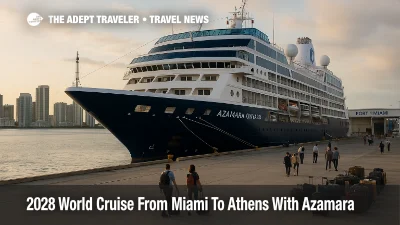
Cuba Blackout Disrupts Havana Hotels And Winter Trips
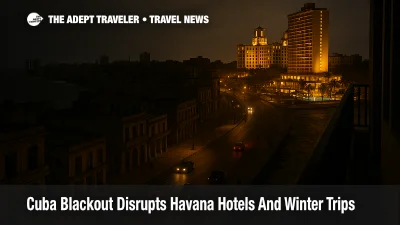
Melissa Cuts Jamaica Rooms, Shifts Dominican Winter Trips
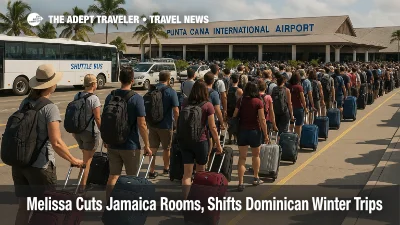
Hurricane Melissa Recovery Boosts Dominican Republic Flights
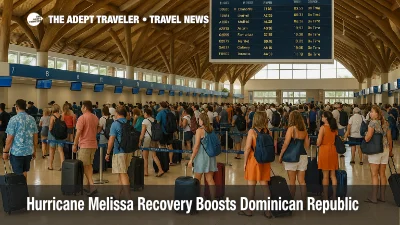
Cuba Blackouts And Melissa Damage Hit Tourism
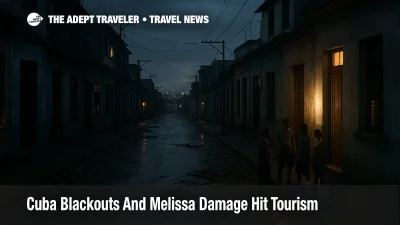
U.S.-Cuba Flights Tighten as Delta Cuts, United Exits

Hurricane Melissa: Cuba Airports, Power, and Travel

Cuba Next: Hurricane Warnings, What Travelers Should Do

Hurricane Melissa, Track And Travel Impact This Week

Melissa Intensifies, Waivers Issued for Jamaica, Hispaniola

Caribbean disturbance could become Tropical Storm Melissa

Caribbean tropical disturbance may alter late-week cruises

Royalton debuts Royalton Suites & Villas for Diamond Club

Chikungunya in the Caribbean: What travelers should know

Hurricane Gabrielle brings dangerous surf; Narda turns away

Cuban Electrical Grid Collapse Triggers Island-Wide Blackout

United pauses Houston to Havana, Southwest trims Tampa to Havana

Tropical Storm Fernand swells near Bermuda, East Coast

Caribbean travel demand surges, Aruba, D.R., Jamaica lead

Cat-5 Hurricane Erin drives SXM, USVI cancellations

Tropical Storm Erin Forecast: Insurance Clock, Swell Risks

